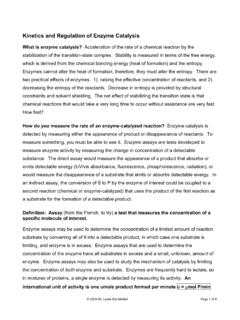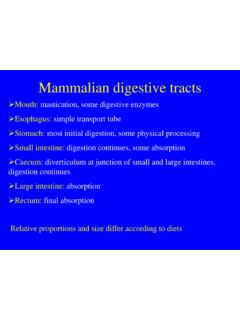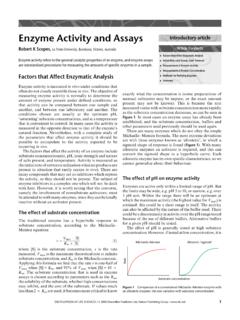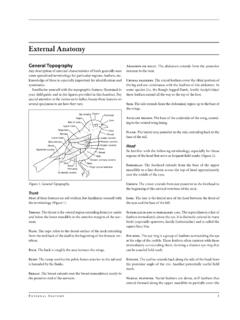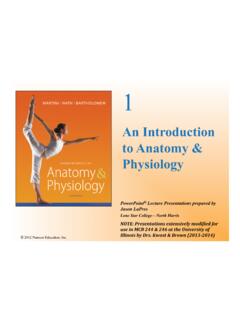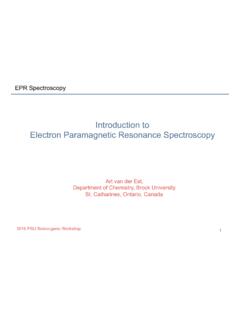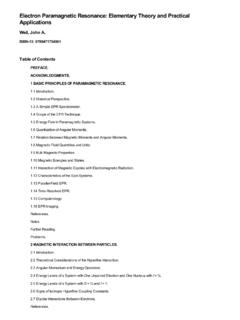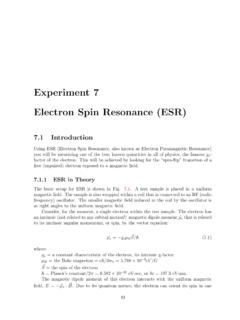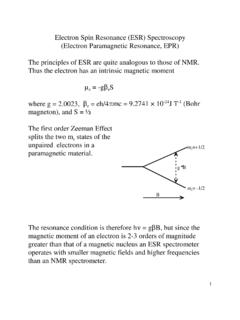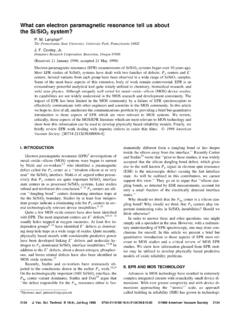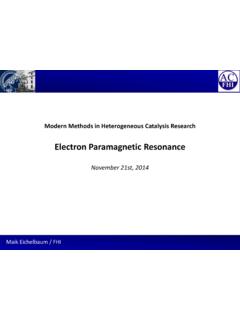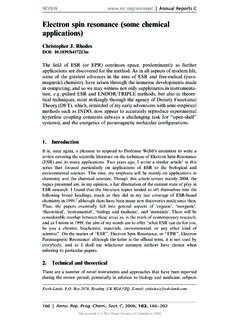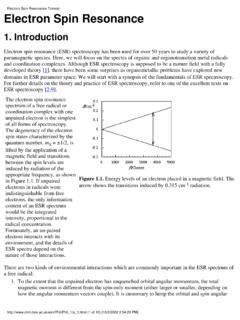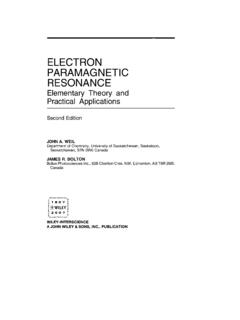Transcription of CHAPTER 3 ELECTRON PARAMAGNETIC RESONANCE …
1 CHAPTER 3 electron paramagnetic resonance SPECTROSCOPY1 Sergei A. Dikanov and2 Antony R. Crofts1 Department of Veterinary Clinical Medicine and 2 Department of Biochemistry,University of Illinois at Urbana Champaign, Urbana IL 61801, INTRODUCTIONThis CHAPTER is devoted to magnetic RESONANCE spectroscopy for the investigation of unpaired ELECTRON spins. Two terms are used in the literature: ELECTRON PARAMAGNETIC RESONANCE (EPR) and ELECTRON spin RESONANCE (ESR). We will use the first term in this CHAPTER . During the sixty years since its discovery in 1944 by Zavoisky [1], EPR spectroscopy has been exploited as a very sensitive and informative technique for the investigation of different kinds of PARAMAGNETIC species in solid or liquid states.
2 The first two parts of the CHAPTER introduce the theoretical background and instrumentation used in two complementary approaches to EPR spectroscopy , , continuous-wave and pulsed EPR. The final part describes typical areas of solid state applications. This CHAPTER is based on extensive literature devoted to the EPR spectroscopy . Space limitations preclude references to all original publications and the reader is therefore referred to earlier reviews for a more complete survey of earlier work. Excellent textbooks in EPR spectroscopy cover basic materials [2 5].
3 Many monographs are devoted to the consideration of more specific topics including theory, instrumentation, or application to selected PARAMAGNETIC species [6 19]. Handbooks of EPR spectroscopy [20, 21] are also available, as are periodic reviews on theory, experimental approaches, and different EPR applications covering the period since 1971 [22].A comprehensive description of pulsed EPR spectroscopy is given in the recently published book of Schweiger and Jeschke [23]. Previous literature on pulsed EPR includes two monographs [24, 25], several edited books [18, 19, 26, 27], and a large number of reviews.
4 An up-to-date list is provided in [23].3. ELECTRON PARAMAGNETIC RESONANCE THEORETICAL BACKGROUND EPR Condition The simplest treatment of the EPR experiment is in terms of a PARAMAGNETIC center with an ELECTRON spin of S =1/2, and this in practice covers a wide range of experiments. Representative examples of such PARAMAGNETIC species include ions of transition metals, free radicals, trapped electrons and atoms, and F-centers in alkali halides. The magnetic moment Pe of the ELECTRON is given by the expression Pe= geEeS( )whereEe is the Bohr magneton equal to e /2mc = 10 23 J T (e and m are charge and mass of the ELECTRON , respectively) and ge is a dimensionless constant called the ELECTRON g-factor, which is equal to for the free ELECTRON .
5 (In this and other equations, bold terms are vectorial.) The energy of interaction of the ELECTRON magnetic moment with the magnetic field B isE= ( )If we assume that the magnetic field is directed along the z-axis of the coordinate system, this becomes E = geEeBSz. ( ) For an ELECTRON spin S=1/2 there are two energy states: Er= geEeB ( ) variously labeled n (up), + or D, or p (down), , or E, corresponding to parallel and antiparallel orientations of Sz to the magnetic field (Figure ).Figure Two-level system in varying magnetic field.
6 RESONANCE condition. 98 Application of a magnetic field B1 perpendicular to B, oscillating with the frequencyQo, induces the EPR transition if the RESONANCE condition 'E=E+ E-=hQo = geEeBo ( ) is satisfied. The transition is commonly referred to as a spin-flip, and 'E is the photon energy needed to flip the spin population. The frequency, Qo, and the fieldBo, are the RESONANCE frequency and field. Continuous Wave EPR Real samples contain a large number of spins distributed in the constant magnetic field between the two allowed energy states according to thermal equilibrium. The relative population of two levels is described by the Boltzmann distribution N+/N = exp('E/kT), ( ) wherek is the Boltzmann constant and T is the temperature of the sample.
7 For the free ELECTRON with ge = , the spin population ratio is ~ for a field of Tesla (for the most commonly used X-band EPR), or about 1 in 670 excess spins in the lower energy state. The oscillating magnetic field at the RESONANCE frequency Qoinduces transitions from up to down and from down to up with equal probability. However, the population of lower energy is larger than that of the upper one, leading to a larger number of transitions to the upper level, and, as a consequence, to energy absorption by the sample. This effect is the basis for the simplest and most widely used experimental approach, the so-called continuous wave (CW) EPR experiment, in which the sample containing PARAMAGNETIC species is irradiated by microwaves with frequency fixed by the source, and the magnetic field is varied to search for the microwave absorption.
8 The dependence of microwave absorption on the magnetic field observed in such an experiment is the EPR EPR Lineshape: Relaxation TimesFurther consideration of a CW-EPR experiment is simplified by introduction of a macroscopic magnetization vector. In a constant magnetic field Bo, a population of ELECTRON spins acquires a magnetic moment Mo, which is parallel to Bo under thermal equilibrium conditions. The equilibrium magnetization reflects the difference in population among the various spin states, whose degeneracy has been removed by the magnetic field, and is proportional to Bo.
9 For the spin S= 1/2 there are only two spin levels, and the equilibrium magnetization with Bo applied along the z direction Theoretical Background 3. ELECTRON PARAMAGNETIC RESONANCE Spectroscopy22eo4E BMzNgkT ( ) N=N++N is the total number of spins in the sample. Following excitation by microwave absorption, the spin-flipped population relaxes back to the thermal equilibrium state. The time to return to the equilibrium distribution of magnetization is the relaxation time. Relaxationtime is described by a single exponential decay. Relaxation time along the direction of a static magnetic field Bo is called the longitudinal relaxation time T1.
10 The longitudinal relaxation is accompanied by a change of the energy of the spin system. The thermal motion is the source and sink of energy exchange in the relaxation processes. In solids, thermal motion is usually described by phonons, which are quanta (photons) with energies in the range corresponding to lattice vibrations. Longitudinal relaxation is caused by absorption or stimulated emission of phonons. Since a coupling between the spin system and the lattice is required, the longitudinal relaxation is often calledspin-lattice relaxation. The term lattice comes from its use in early studies performed with ionic lattices.
